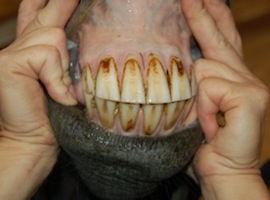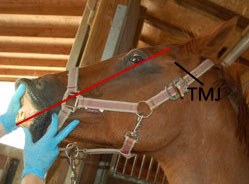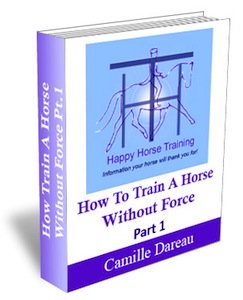| Back to Back Issues Page |
 |
|
The Whole Horse No. 29 - The Truth About Teeth September 09, 2013 |
Mouth Management: The Truth about TeethSpotlight On Management Our quest at HHT is to find ALL the pieces of the jigsaw which make up Holistic Horse Keeping. That includes training, riding, horse society, nutrition, foot trimming, health and therapy for horse and rider. It also includes the horse's mouth, which is as important as any of the rest. The old saying 'no foot, no horse' is very true, but 'no teeth, no horse' is just as pertinent. We also want to introduce the idea, that 'no teeth, no training' is also true, to a degree that most of us are unaware of. The idea of rasping sharp edges is familiar, as well as, perhaps, the concept of balancing a horse's mouth. When a horse's upper and lower jaw come into contact with each other (to eat), they have a certain quality of what can be termed "grind" and "occlusion". Grind means how well the surface of teeth contact each other, and occlusion is how soon they come into contact with each other (expressed in terms of the width of a tooth). An insufficient occlusion would be more than three quarters of a tooth, so the grinding surface is relatively narrow, whereas an efficient occlusion would be half a tooth or less. Good occlusion promotes good grind, because the teeth are meeting over the maximum distance and the best chance of a good wear pattern. Recently our Equine Dentist, Dan Astle-Carter, went on a course about the importance of incisor reduction. We had never heard of it before, and had no idea of the consequences of leaving out this part of the picture, as most equine dentists do. Of course there is easily available information which states the importance of balancing both the cheek teeth and the incisors, but in practice it is rarely done - probably because horses don't like the feeling of having their incisors rasped, therefore sedation is usually necessary. We are in the process of realizing just how influential it might be in terms of overall health and training of our horses, so we will share our initial thoughts with you.
The theoretical choice could be seen to be that equine dentistry is normally a question of preserving the level of occlusion a horse already has, and preventing it from deteriorating further. In practice - taking our 20 horses at HHT as evidence - if the incisors are not included in the overall balancing of the mouth, the occlusion will deteriorate anyway over time, and including incisor reduction can improve existing occlusion, even in a very young horse. Evidence against this conclusion seems to be as simple as "there are plenty of fat horses with uneven/over long incisors" which is a simplistic view at best. In terms of weight gain, the largest influence, by far, is metabolism, and there are plenty of horses living their whole lives with terrible teeth who will only begin to fail in old age, when their metabolism is failing. Just 'being fat' isn't enough for us anyway, what we are concerned with is comfort, and whether or not we are giving our horses the best chance of that, which brings up the subject of training.
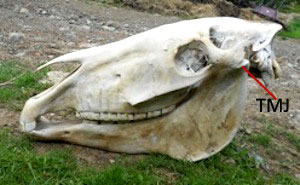
The following scenario is the basic understanding we are coming to about the process and the cause of Tempero-mandibular joint (TMJ) problems in horses. We can't, at this time, know how it compares quantifiably with the other large scale TMJ aggravator - bad riding, which, at its best, is caused by lack of rider balance (seeking support in the rein) and at worst, is intentional 'violence' against the horse's mouth. All that we know is that one problem will exacerbate the other. Most people know that horses have a 'handedness' like people, it manifests as a crookedness through their bodies (known as their 'natural bend'), as well as affecting which side of their mouth they prefer to chew on. Over time, this chew pattern will often affect the back teeth, resulting in a steeper and shallower side. A good dentist will address this, but the chew pattern also affects the incisors, and uneven patterns will show up, to a greater or lesser extent. These are termed 'smiles', 'frowns' or incisor slants.
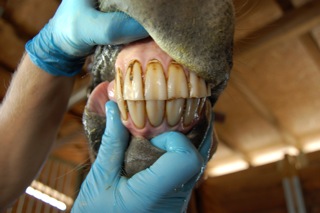
Right: A slight incisor 'frown', when the bite curves up slightly in the middle. 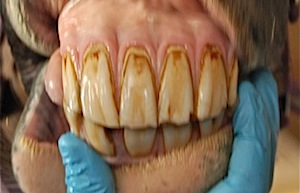
Left: seriously overgrown and steep incisors, with a marked slant from the LHS up to the RHS. This slant has been exacerbated by the fact that one of the lower incisors has been fractured, and the upper has grown into the gap. 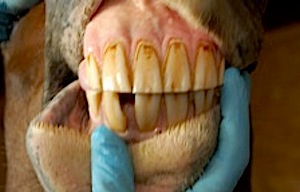
Left: The same mouth after an incisor reduction and re-balancing In a similar way to horse's feet (which also grow throughout their lives, and are hard and relatively 'fixed') when the incisors take on such a pattern, they will then begin to disturb the rest of the skull, and the misalignment will only worsen over time. There is a school of thought which says that regular balancing of the cheek teeth will keep the incisors balanced without any need to touch them. It sounds reasonable, but our horses, who have always been balanced regularly in the back of their mouths, all had extremely long incisors, of which only two did not display one of the imbalances mentioned above. The issue for our training (and first and foremost the comfort of our horses) is that when the Temporo-mandibular joint becomes misaligned as a result of incisor imbalance and length, the existing crookedness pattern of the horse will become more and more 'fixed'. The horse will find it increasingly hard to soften their jaw and flex at the TMJ, and straightening work will become impossible without coercion. As we know anyway, coercion only creates tension, which forms a barrier to true communication between horse and rider on any level. 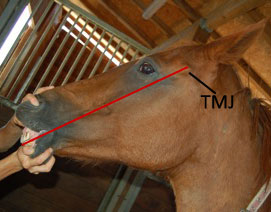
These pictures show that before the incisor work, the angle pointed higher than the TMJ (shown by the red line in the picture, above), but with the re-balancing the angle is aligned with the TMJ (picture right). Recently we introduced a major change in our management practices, changing from loose hay to the slow feeder nets. We believe that the fact that the horses are chewing for a much longer period every day may have intensified the effects of the TMJ problems which were steadily coming about. It is certainly true that some horses in particular seemed more one-sided in their mouths, despite progress in their general balance and posture. Over this last week, all of our horses have had incisor work and overall re-balancing. The occlusion figures, (many of which were at one tooth's width or more - despite having had their cheek teeth done this summer) were reduced by a quarter to half a tooth on average. Some of the horses with very uneven occlusion values one side to the other, (moving the jaw left or right) did not even-up completely. For example one horse, Mojo, had one tooth's width to the left and slightly less than one to the right, which came down to 0.7 left, and 0.3 right. This would make sense, because he has had an uneven bite for a long time, and all the structures in his skull will support that, so change has to be gradual.
We will be following up with news on how the horses are feeling to ride since this work, and any changes in their behavior, weight or eating patterns. We will also write-up our findings on how tooth wear patterns correlate with natural-crookedness and 'handedness' - a subject of profound importance for any training method which involves the gymnastic straightening of the horse.
See and share topical news, info and photo's on the Happy Horse Training Facebook group. Once you join you can take part in lively disscusion on subjects relevant to holistic equitation, and make friends with like-minded people all over the world.
Just Click here to go to the HHT group page, and then click on the 'join group' button at the top right of the page.
Sharing the Holistic Message
If you enjoy Happy Horse Training and you find the information on the site useful, please help us to share it by clicking on the Facebook 'like' and 'share' buttons (if you have a fb account) that are on each page. Any other way you can pass the site on to friends and colleagues via, for example, discussion forums, is of course also greatly appreciated. You can also sign up to our RSS feed (blog) to be kept up to date with new ideas, pages and other information that we post there. Just click on the box that says 'subscribe to this site' at the left of each page. The equestrian world is one dominated by traditionalist ideas and conventions, but we like to think we can help inform the growing minority of horse-owners who want to make their horses happier with progressive and holistic methods.
Happy Horse Training now has over 100 pages exploring many different areas of holistic equitation. Do have a look through our site plan to find the subjects and categories that interest you.
Available from HHT:
New! The Gymnastic Rider eBook 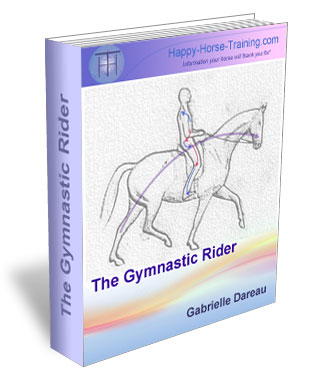 Available exclusively from HHT, a unique and comprehensive guide to practical rider biomechanics. This professionally produced eBook takes the rider through the process of developing their body in the specific way that brings the horse's movement into harmony and balance, without force and constraint.
Available exclusively from HHT, a unique and comprehensive guide to practical rider biomechanics. This professionally produced eBook takes the rider through the process of developing their body in the specific way that brings the horse's movement into harmony and balance, without force and constraint. The information in this book, including over 55 000 words, represents what we would normally pass on in a minimum of 12 specialist lunge lessons, focusing on each part of the position and its influence on the horse, with a value of at least €450. The Gymnastic Rider is available for only €29.99. Click here for full details, and to download the 15-page introduction to the book for free.
How to Train a Horse Without Force eBook With your purchase you will receive a free bonus supplement on Horse Trauma - cutting edge insights on this subject that up until now have mostly been applied only to human trauma. This supplement shows how to recognise, avoid and deal with horse trauma, which is much more common that we realise. These two e-books - How to Train a Horse Without Force and Horse Trauma comprise more than 75 thousand words and are richly illustrated. They are available for only 19.99 Euros (around $26). Click here for more details.
|
| Back to Back Issues Page |
